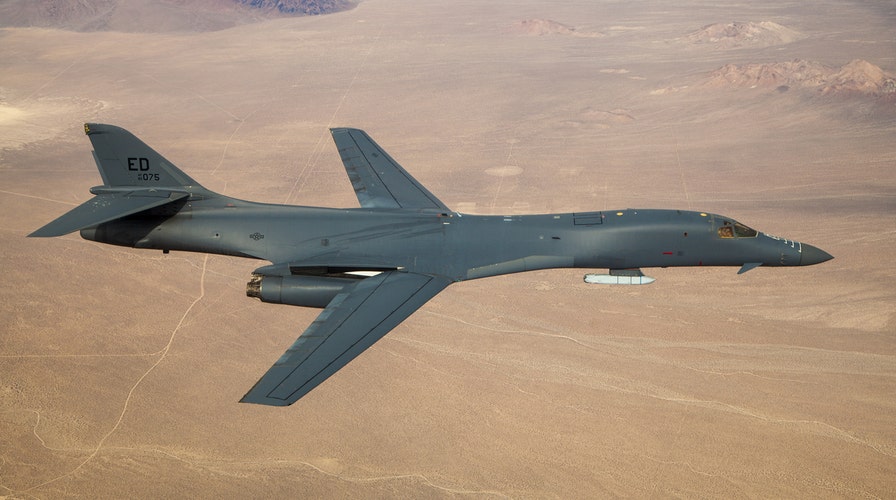Fox News Flash top headlines for November 29
Fox News Flash top headlines are here. Check out what's clicking on Foxnews.com.
The U.S. Air Force’s decades-old, combat-tested B-1B Lancer aircraft has just taken a huge step toward developing an ability to fire hypersonic weapons in flight, as the Air Force has released images of the aircraft flying at Edwards Air Force Base in California with a missile loaded underneath the fuselage on an external pylon.
The photo, released by the Air Force in November of this year, has generated a massive amount of attention in light of the fact that it may represent a sizable leap forward toward actually deploying a hypersonic-missile armed B-1.
The Lancer was armed with a Joint Air-to-Surface Standoff Missile mounted under an external pylon, the service said in a news release.
“Adapting a small number of our healthiest B-1s to carry hypersonic weapons is vital to bridge between the bomber force we have today, to the force of tomorrow,” Gen. Tim Ray, head of the Air Force Global Strike Command, said according to the statement.
NEW AIR FORCE STEALTH BOMBER ARRIVES IN JUST '2 YEARS'
Interestingly, the development appears to build upon previous Air Force work to develop a mock-up B-1B weapons bay, showing that the aircraft can carry as many as four hypersonic weapons internally.

A B-1B Lancer with a Joint Air-to-Surface Standoff Missile (JASSM) flies in the skies above Edwards Air Force Base, California, Nov. 20, 2020. (Air Force photo by Ethan Wagner)
“In a demo I saw recently, the bulkhead moves as its designed...when you take a CRL (Conventional Rotary Launcher) as its designed. The mock up they had was one of the larger hypersonic weapons. It will be able to carry four or more hypersonic weapons internally. You can see the merit of that,” Ray told reporters in 2019 at the Air Force Association Convention.
At the time, Ray went on to explain that the service was interested in developing both external hardpoints on the B-1B as well as an extended bomb-bay. He also made a comment which, in retrospect, seems to have anticipated the Air Force’s recent carriage flight with a JASSM, as he mentioned that the “the external hardpoints can carry the smaller hypersonics along with JASSM (Joint Air to Surface Standoff Missile, JASSM ER(extended range) and LRASM(Long Range Anti-Ship Missile). You can see a greater versatility for that aircraft configuration.”
The demo referred to by Ray also demonstrated that the bomb-carrying capacity of the B-1B can increase from 24-internally carried weapons all the way up to 40, Air Force officials said.
PENTAGON DEPLOYS NEW SUB-LAUNCHED, LOW-YIELD NUCLEAR MISSILE
“This gets the B-1 into the larger weapons, the 5,000 pounders. It gets it into the hypersonics game as well,” Lt. Col. Dominic Ross, B-1B program element monitor, AFGSC, (Air Force Global Strike Command) said in an Air Force statement.
Accommodating larger hypersonic weapons into a B1 bomb-bay brings a number of strategic implications; not only does it massively increase the target envelope and range but also allows for longer mission “dwell” time over targets to sustain attacks. Also, in an age where modern air defenses operate with much greater range, scope and precision when compared with years past, arming a B-1 with hypersonics introduces an entirely new sphere of high-speed standoff attack.
Also, the B-1B Lancer will keep flying to fight another day, at least for several more years until enough B-21s arrive, a scenario that has inspired the service to extend the bomber’s service life and performance capacity through a series of upgrades and technical overhauls.
In recent years, the Air Force has been working on a range of massive improvements to the B-1, giving it improved weapons capacity, avionics, communications systems and engines.
NAVY ARMS SEA DRONES FOR OCEAN ATTACK
A demo as recently as last year, for example, showed that the B-1 could increase its bomb-carrying load from 24 up to 40 in the internal weapons bay. The B-1 has also been increasing its carriage capacity of 500-pound class weapons by 60-percent due to what Air Force weapons developers explain as Bomb Rack Unit upgrades.
The B-1s also continue to get refurbished engines and improved targeting and intelligence technologies, service leaders told Warrior.
A new Integrated Battle Station includes new aircrew displays and communication links for in-flight data sharing, a system that Air Force developers have explained includes machine-to-machine interface for on-the-move information adjustments such as a need to change target locations in flight. Part of this upgrade involves the use of what the Air Force calls the Fully Integrated Targeting Pod, a system that merges targeting pod controls with video feeds sent into the aircraft’s cockpit.
The B-1 can hit speeds of MACH 1.25 at 40,000 feet and operates at a ceiling of 60,000 feet. It fires several JDAMS: GBU-31, GBU-38 and GBU-54. It also fires the small diameter bomb-GBU-39.
CLICK HERE TO GET THE FOX NEWS APP
The B-1, which had its combat debut in Operation Desert Fox in 1998, went on to drop thousands of JDAMs during the multi-year wars in Iraq and Afghanistan. The role of the B-1 during the Iraq and Afghanistan wars is lesser-known or at least lesser recognized, yet the bombing missions it performed over the years were considered crucial to U.S. military progress.
Kris Osborn is the Managing Editor of Warrior Maven and The Defense Editor of The National Interest --

